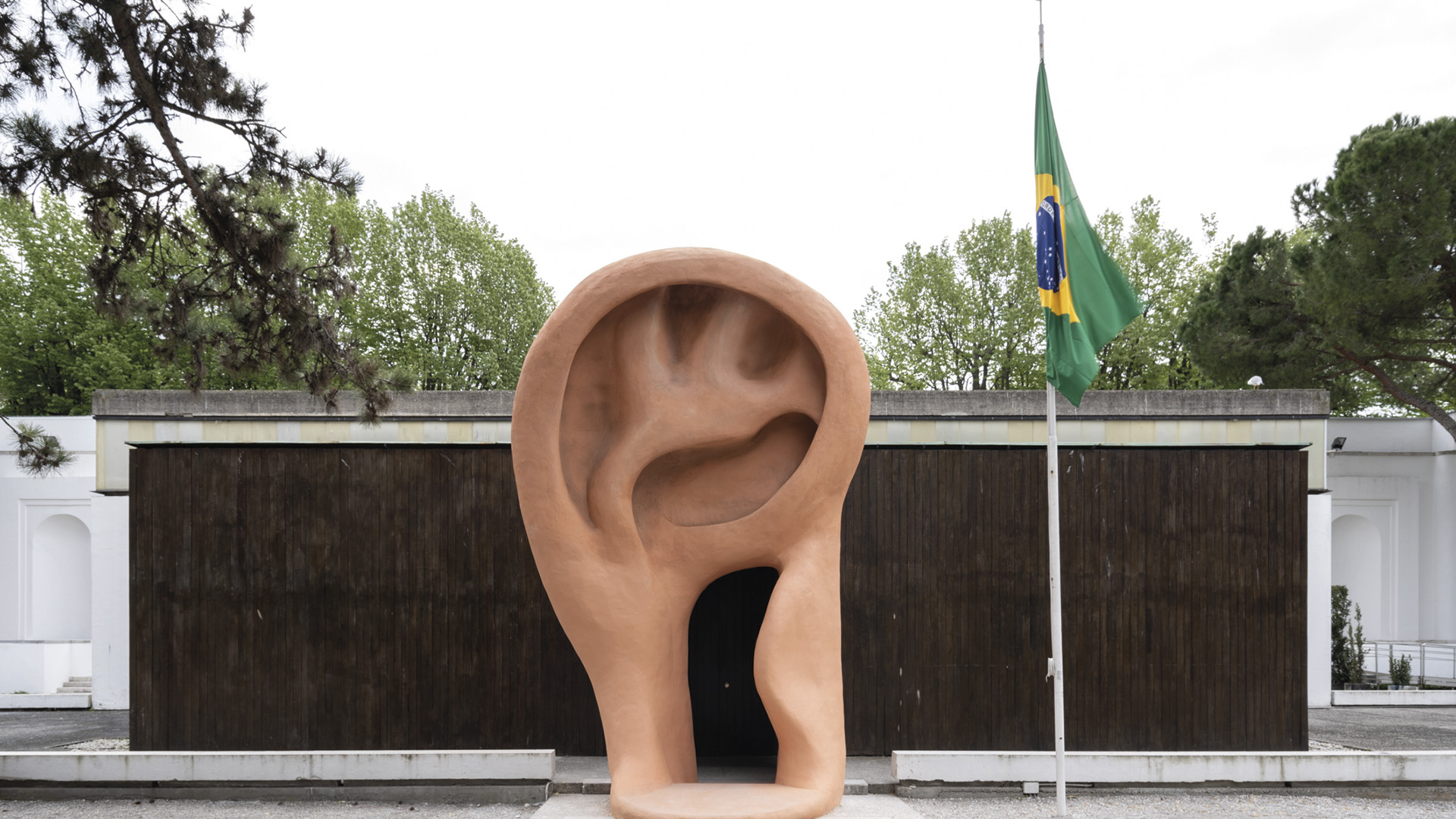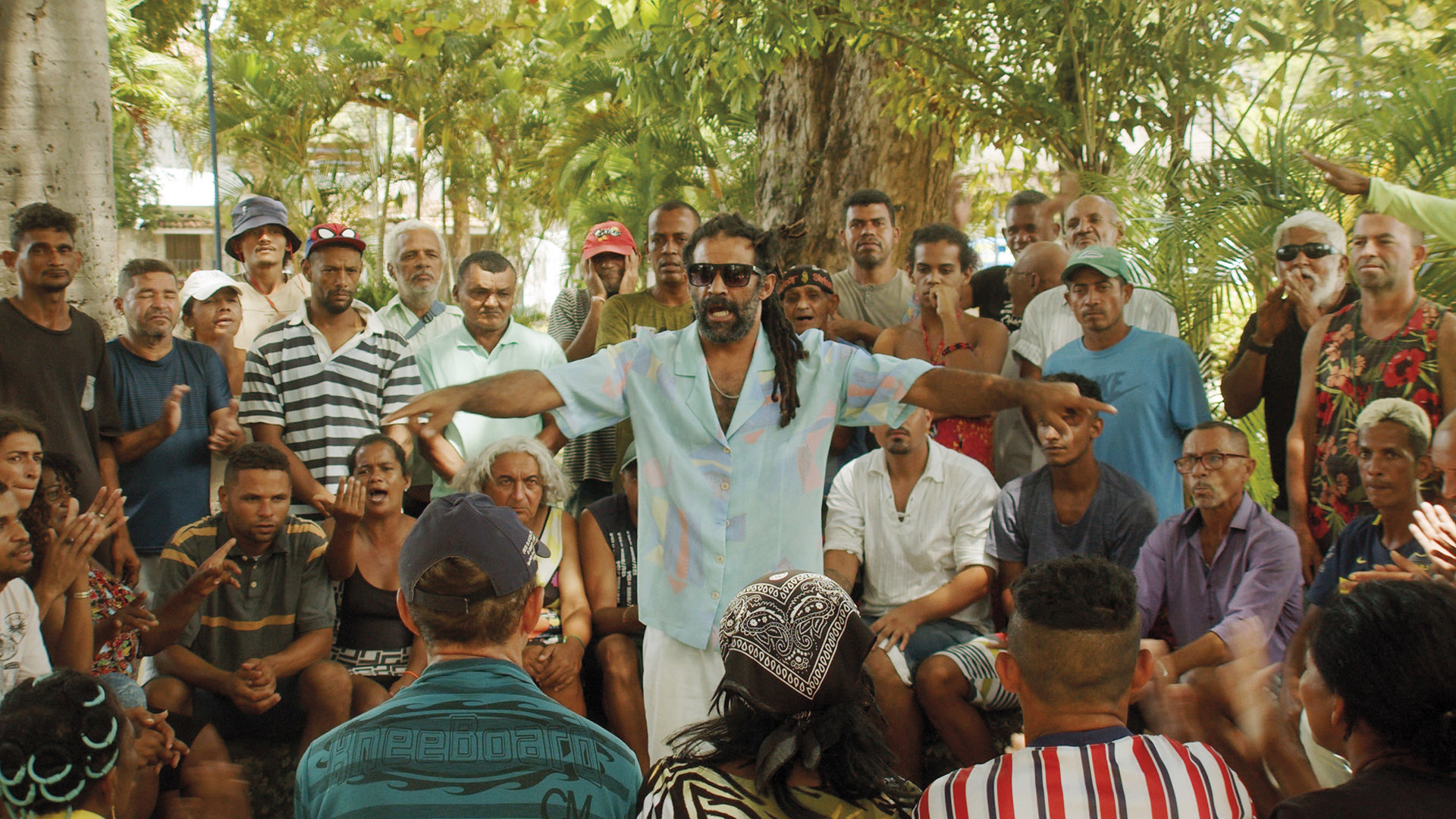

At the Brazilian Pavilion and in the exhibition Penumbra (Ospedaletto CON/Temporaneo) De Andrade’s installations, photographs, and video explore the effects of power dynamics and social conflicts in his country.
Jonathas De Andrade (Maceió, Brazil, 1982) lives and works in Recife, Brazil. His installations, photographs, and video explore the effects of power dynamics and social conflicts in his country as well as the evolution of humankind and ethics. His goal is to communicate the effects of colonialism, slavery, and modernist culture, which influenced profoundly Brazil’s history due to the many relevant political decisions taken during the twentieth century. De Andrade is undoubtedly one of the protagonists at the 2022 Art Biennale, both as the artist representing Brazil (his project With the Heart Coming out of the Mouth, curated by Jacopo Crivelli Visconti, is an immersive, symbolical journey into the human body with metaphors that range between nostalgia, eros, and historical-political critique) and as independent exhibition Penumbra at the Ospedaletto. Penumbra, curated by Alessandro Rabottini and Leonardo Bigazzi and promoted by Fondazione In Between Art Film, features a video, Boca Livre, that sees the artist interacting with a group of homeless people gathered for a Sunday lunch. De Andrade questions how art can be a political tool for speculative narration. A genial type with self-awareness to boot, we spoke with Jonathas to gain a privileged access into his Brazil.
Human body parts of a ravaged body, wounded limbs of a Brazilian body – literally torn into fragments and silenced. A metaphor of a fragmented country: the Brazil of today, at least the way it is shown in international news. How would you define your country? What is Brazil today?
The several body parts that we see in the Brazilian Pavilion exhibition represent the fragments of the collective body that has been oppressed – and compressed – by the sad history of the last few years. Brazil has been facing challenges and threats in the fields of human rights. We are looking at indigenous genocide, grave issues in healthcare, education, culture, basic human rights, especially in the most vulnerable populations. The project at the Brazilian Pavilion shows how untranslatable it is to express the feelings of awkwardness and despair that are all about Brazil currently. Language can be a strong metaphor to show how collectiveness may be the way out to create new responses, new paths, new narratives, and new political ways to reinvent our own history.
The ear means listening. Does your art communicate dissent from Bolsonaro’s politics? How can art, today, criticize illiberal politics?
Things have been happening without listening. So it’s not by chance that the visitors of the Pavilion are invited to enter through one ear and come out from the other. They will also find a rotten finger pushing the button of our voting machines, and they will see sculptures, photographs, and video that comment, sensorially, on the metaphors that play with the political and social atmosphere of present-day Brazil, its contradictions, and its challenges. Brazil will vote in October: we have a chance and a great responsibility to change the path Brazil is on right now.
The ‘legend’ says that as a child, you were struck by an exhibition on the human body where you literally took a voyage inside one. What is discovery for you? And when did you understand that art was going to be your life itinerary?
I was four years old, when I visited the Boneca Eva, a giant doll that, as an exhibition, travelled around Brazil. You could enter her body and see how all the organs worked, how pregnancy took place, and so on. It was a quite striking experience for me. It showed how science and fantasy could play together to teach something. The project for the Brazilian Pavilion plays with the idea of a science fiction fair. By using the human body as a metaphor, we can understand other types of lessons: linguistic, social, political. My childhood taught me that the artist I would become liked to combine characters in order to tell new stories, playing with language, methodologies, new narratives, play with fiction and non fiction, inviting people to take their own repertoire and complete the fantasy deciding what is fantasy, what is true or not, and what are the messages of inspiration or urgency that are behind what we see.

Brazil is a country of contradictions, and in your new video Boca Livre in exhibition Penumbra, produced by Fondazione In Between Art Film, you show the suffering of living in impoverished conditions. You are able to tell a story without resorting to pain rhetoric at all costs – instead, you convey natural empathy in a refreshingly simple way. Deep insight and no detectable distress. What are the cornerstones of your art, as seen in this video?
Video project Olho da Rua is an experience of gaze – of looking – featuring a group of one hundred homeless people from my city. Over the last several years, hunger increased in Brazil, and the number of homeless people did, too. I felt the urge to say something, to make a project that involved these people. Getting closer to people is always a powerful experience: the art project is an excuse, what I wanted was for everybody to learn something by means of this adventure. An important source of inspiration for this project is Augusto Boal’s Theatre of the oppressed. The idea is that people representing themselves in theatre or in front of a camera can rearrange narratives and challenge the way they are seen by other people as well as the way they see themselves. This is why my understanding of this project is a series of ways to comment on the beauty and delicacy of the respect that is needed and that appeals to each individual so that each can resonate and shine through the power of the collective.
The round-up of faces shown in the tracking shot, like an uninterrupted stream of lived life highlighted by the music’s rhythm, creates an incredibly powerful and direct film sequence. Shots look like individual portrait photographs set in motion. How did you choose video as your language of expression, and why?
Some projects find their perfect strength in the format of video, some other work well as photography. Playing with space is also quite interesting. The scene you describe has a rhythm and it’s powerful to see the way it is: in a huge screening, in slow motion, strong people looking at us. For Olho da Rua, I think it was pretty clear that a theatre experience was the ideal way to organize and share the exhibition space.

Nature is an element in your work, especially as part of the Nature/Man pair. In your videos, there is a sort of mutual respect, or awe, between man and animal. What research have you conducted before creating this art?
The conflicting relations between humanity and nature fascinate me, especially how we, as a society and as a civilization, understand ourselves as the dominant species in such a delirium that we forget we are animals, too, and we are a natural species ourselves. We behave as if we were disconnected, as if we stood completely above, detached from the world. I use art to explore the limits of these conflictual relationships, for example in my video piece O peixe and in the film Nó na garganta (Knot in the Throat), which are shown at the Brazilian Pavilion. As humanity, we still couldn’t find a proper solution on the contradictions of being alive in this planet, but I believe art can help us formulate subjective and emotional ways in this long journey.
Featured image: Ph. Emanuel da Costa